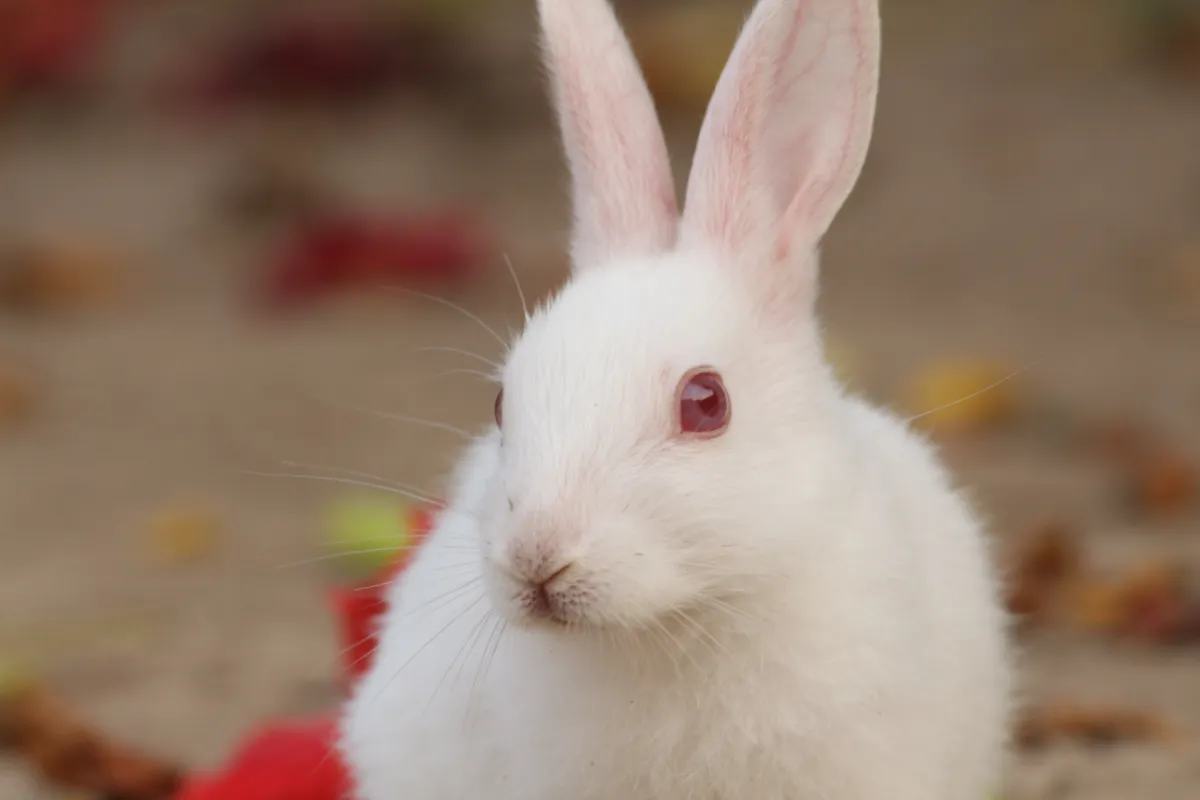Have you ever wondered why white rabbits have those striking red eyes?
In this article, we delve into the fascinating genetic basis behind this intriguing phenomenon.
Through a scientific exploration, we uncover the role of melanin and pigmentation, the impact of albinism, and the influence of environmental factors on eye color.
Additionally, we examine whether red eyes in white rabbits serve as an indicator of health or disease.
Prepare to uncover the secrets behind those mesmerizing ruby-red eyes.
In This Article
- 1 Key Takeaways
- 2 The Genetic Basis of Red Eyes in White Rabbits
- 3 Melanin and Pigmentation: Explaining the Red Eye Phenomenon
- 4 The Role of Albinism in White Rabbits’ Eye Color
- 5 Understanding the Physiology of Red-Eyed White Rabbits
- 6 Environmental Factors and Red Eye Color in White Rabbits
- 7 Red Eyes as a Sign of Health or Disease in White Rabbits
- 8 Frequently Asked Questions
- 8.1 How Do White Rabbits With Red Eyes See Compared to Rabbits With Other Eye Colors?
- 8.2 Are There Any Other Animals Besides Rabbits That Have Red Eyes?
- 8.3 Can the Red Eye Color in White Rabbits Change or Fade Over Time?
- 8.4 Are White Rabbits With Red Eyes More Prone to Certain Health Issues Compared to Rabbits With Other Eye Colors?
- 8.5 Are There Any Specific Care Requirements for White Rabbits With Red Eyes, in Terms of Their Eye Health?
- 9 Conclusion
Key Takeaways
- White rabbits with red eyes have a specific genetic mutation that affects the production of pigments in their eyes, resulting in the absence of pigmentation in the iris and the red appearance.
- Albinism is the genetic condition that causes the lack of pigmentation in the eyes of white rabbits, allowing blood vessels to be visible and giving a red reflection.
- Red-eyed white rabbits may experience vision problems such as photophobia and reduced visual acuity, but not all of them have vision issues.
- Environmental factors like diet, temperature, light exposure, air quality, and stress levels can influence the intensity and changes in red eye color in white rabbits.
The Genetic Basis of Red Eyes in White Rabbits
You should read the article about the genetic basis of red eyes in white rabbits.
Understanding the genetic mutations that lead to these hereditary traits is essential in serving others who work with rabbits, such as breeders or veterinarians.
Red eyes in white rabbits are caused by a specific genetic mutation that affects the production of pigments in the eyes. This mutation results in the absence of pigmentation in the iris, causing the eyes to appear red.
It’s important to study these genetic mutations to better understand their inheritance patterns and potential impacts on rabbit health.
Melanin and Pigmentation: Explaining the Red Eye Phenomenon
There’s a lot to learn about melanin and pigmentation and how they contribute to the red eye phenomenon in white rabbits. When it comes to eye color inheritance, genetic mutations play a crucial role. White rabbits have a lack of pigmentation in their eyes, which allows the underlying blood vessels to show through, resulting in the red eye appearance. This phenomenon occurs due to the absence of melanin, the pigment responsible for giving color to our eyes. Melanin acts as a natural sunblock, protecting the eyes from harmful UV radiation. In the absence of melanin, the blood vessels in the retina become more visible, leading to the red reflection. Understanding the genetic mutations and the role of melanin and pigmentation in white rabbits’ eyes can help us better care for these animals and provide them with the necessary protection they need.
| Genetic Mutations | Eye Color Inheritance | Red Eye Phenomenon |
|---|---|---|
| Albinism | Recessive gene | Lack of melanin |
| Oculocutaneous albinism | Autosomal recessive inheritance | Visible blood vessels |
| Ocular albinism | X-linked inheritance | Red eye reflection |
The Role of Albinism in White Rabbits’ Eye Color
Albinism is a genetic condition that results in the absence or reduction of melanin, the pigment responsible for giving color to the skin, hair, and eyes. This phenomenon occurs because without melanin to absorb and reflect light, the blood vessels in the iris become more prominent. Albinism affects the eye color of white rabbits, causing them to have red eyes. In white rabbits, the lack of melanin in their eyes allows the blood vessels to be visible, giving them a red appearance. The same red eye phenomenon can be observed in other albino animals, such as mice, rats, and ferrets.
The absence of melanin not only affects the eye color but also impacts the vision of albino animals. Albinism is often associated with various vision problems, including photophobia, nystagmus, and reduced visual acuity. Understanding the role of albinism in white rabbits’ eye color and vision is essential for providing appropriate care and support to these animals.
Understanding the Physiology of Red-Eyed White Rabbits
Although the exact mechanism is not fully understood, researchers have found that the red-eye appearance in white rabbits is due to the reflection of light off the blood vessels in their eyes. This unique characteristic has sparked the interest of scientists and has also played a role in folklore and mythology. White rabbits with red eyes have long been associated with mystical and magical creatures in various cultures. In animal research, the presence of red-eyed white rabbits has both positive and negative impacts. On one hand, their distinct features make them easily distinguishable for experimental purposes. On the other hand, their sensitivity to light and potential vision impairments may limit certain research applications. Understanding the physiology behind the red-eye appearance in white rabbits is crucial for ensuring their welfare and optimizing their use in scientific studies.
| Trait | Red-Eyed White Rabbits |
|---|---|
| Eye Color | Bright red |
| Coat Color | Pure white |
| Vision | Potentially impaired |
| Sensitivity | High |
Environmental Factors and Red Eye Color in White Rabbits
You can explore the relationship between environmental factors and the red eye color in white rabbits. Understanding how diet and temperature impact eye color is crucial in serving the needs of these rabbits. Here are three key points to consider:
- The effect of diet on red eye color in white rabbits: Research suggests that certain nutrients, such as vitamin A, play a vital role in maintaining the red pigmentation in the eyes of white rabbits. A diet lacking in these nutrients can lead to a fading or loss of red coloration.
- The impact of temperature on red eye color in white rabbits: Temperature variations can affect the blood vessels in the eye, leading to changes in eye color. Extreme cold or heat can cause dilation or constriction of these vessels, influencing the intensity of the red color.
- Other environmental factors: Factors like exposure to light, air quality, and stress levels may also contribute to changes in eye color. Further research is needed to fully understand these relationships and their impact on red eye color in white rabbits.
Red Eyes as a Sign of Health or Disease in White Rabbits
Examining the redness and clarity of a white rabbit’s eyes can provide valuable insights into their overall health and potential diseases, while also ensuring their well-being. Red eyes in white rabbits can be caused by a variety of factors, including genetics and underlying health issues. Breeding plays a significant role in the occurrence of red eyes in white rabbits, as certain genetic variations can lead to the expression of red pigments in the eyes. However, it is important to note that not all white rabbits with red eyes will experience vision problems. While red eyes can be a sign of potential vision problems in some cases, it is crucial to conduct thorough examinations and consult with a veterinarian to determine the underlying cause and appropriate course of action.
| Causes of Red Eyes in White Rabbits | Potential Vision Problems |
|---|---|
| Genetic variations | Cataracts |
| Inflammation | Conjunctivitis |
| Infection | Glaucoma |
| Allergies | Corneal ulcers |
Frequently Asked Questions
How Do White Rabbits With Red Eyes See Compared to Rabbits With Other Eye Colors?
White rabbits with red eyes have a different vision compared to rabbits with other eye colors. Their red eyes lack a protective pigment, making them more sensitive to light. This can affect their overall eye health and may require special care.
Are There Any Other Animals Besides Rabbits That Have Red Eyes?
There are other animals besides rabbits that have red eyes. In mythology and folklore, red-eyed animals are often associated with supernatural powers. Genetic factors play a role in determining eye color in different species.
Can the Red Eye Color in White Rabbits Change or Fade Over Time?
The eye color in white rabbits can change or fade over time due to genetic factors. However, it’s important to note that this process is not common and may vary from rabbit to rabbit.
Are White Rabbits With Red Eyes More Prone to Certain Health Issues Compared to Rabbits With Other Eye Colors?
White rabbits with red eyes are more prone to certain health issues compared to rabbits with other eye colors. These health risks include vision impairment and sensitivity to light due to the lack of pigment in their eyes.
Are There Any Specific Care Requirements for White Rabbits With Red Eyes, in Terms of Their Eye Health?
To ensure the eye health of white rabbits with red eyes, specific care techniques are required. This is due to potential health risks associated with their eye color. Regular check-ups and proper cleaning are crucial.
Conclusion
In conclusion, the genetic basis of red eyes in white rabbits is closely tied to the absence of melanin and pigmentation. Albinism plays a significant role in determining their eye color.
Understanding the physiology of red-eyed white rabbits requires considering both genetic and environmental factors. While red eyes may not necessarily indicate a health issue in these rabbits, further research is needed to fully comprehend the intricacies of this fascinating phenomenon.
Like a window into their genetic makeup, the red eyes of white rabbits remind us of the complex and diverse world of biological traits.





